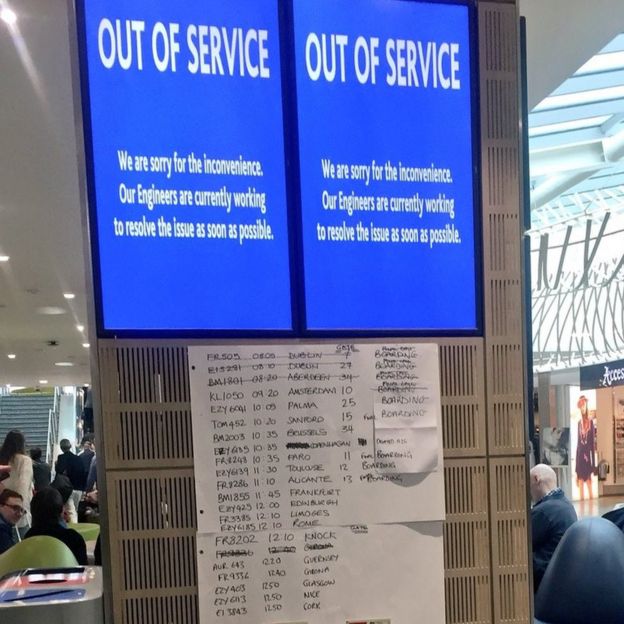A bipartisan effort to revitalize the heartland, one tech job at a time.
Matthew Watson opened his car door at a gas station outside Hueysville, Ky., sprang out and exclaimed, “I got a new job!” He blushed slightly; he was not one to boast. But for this slender, 33-year-old man with a red beard, a father of two small daughters who had once been ashamed of supplementing his low-pay, long-hours job with food stamps, this was fantastic news.
I’d driven to Hueysville past trucks with “Diggin’ Coal” decals, on a road slicing through mountains that rose in steep, majestic steps up to tops flattened by dynamite, past turnoffs to forgotten union halls where the eight-hour workday had been won and billboards that had recently read, “Trump for President.” (Kentucky went 63 percent for him.) Mr. Watson’s home, like much of Appalachia, reflects the landscape and culture of coal, without the coal mining jobs. And there was little hope of alternatives — until now.
“After I got my two associate’s degrees, the best job I could find was selling cigarettes behind the counter in Hazard, a 45-minute commute from home, for $10 an hour, and that was after a promotion to manager,” Mr. Watson told me the first time we met. “Some of my customers were opioid addicts, who slurred their speech, scratched their arms, laid their heads on my counter. In the back of my mind, I always think, ‘If I want to stay living here, if I didn’t have this job, I’d be working that job.’”
Then one day Mr. Watson heard an ad on the car radio. “It was for a 24-week course in coding, with an eight-week apprenticeship, which I later learned could qualify me for a $40,000-plus job designing apps for cellphones,” he said. The advertisement had been put out by a Louisville tech start-up called Interapt. “I immediately applied online, got interviewed, aced the test, and they hired me as an intern and then as a junior software developer,” Mr. Watson said. Within a year, he was offered yet another job as a software engineer, for a Florida-based company, for a salary well over $50,000.
On its first run in 2016, Interapt had 800 applicants, accepted 50 and graduated 35. (Some of the 15 who dropped out did so to tend a sick relative, join the military or take a non-tech job.) Of the 35 graduates, 25 were given job offers by Interapt, and 10 were hired by other tech companies in the area. This year Interapt will train approximately 90 people; next year Interapt expects that number to rise to more than 150.
Ankur Gopal, a University of Illinois graduate from Owensboro, Ky., started Interapt in his basement in Louisville in 2011, when he was 35. He is now renovating an empty warehouse in a run-down part of the city, investing nearly $4 million and creating jobs in the process. “With millions of U.S. tech jobs out there,” Mr. Gopal said, “we could help transform eastern Kentucky. Well, hey — Middle America.”
Mr. Gopal is at the forefront of a new movement to bring money and jobs from the coastal capitals of high tech to a discouraged, outsource-whipped Middle America. Ro Khanna, the Democratic representative from California whose district includes Apple, Intel, LinkedIn and Yahoo, was among the first politicians to float the idea of Silicon Valley venturing inland. “Why outsource coding jobs to Bangalore when we can insource jobs to eastern Kentucky, poor in jobs but rich in work ethic, and every one I.T. job brings four or five other jobs with it?” he said.
The stories of these Interapt graduates in the green hamlets of eastern Kentucky begin with dead ends and end with new beginnings.
“Nights I was manning the reception desk at Super 8, for $7.50 an hour, and days I was working at Little Caesars and still struggling to pay family bills,” Shea Maynard told me. Now, she said, “I’m modifying the information architecture of Interapt products.” She continued, “I never thought it was possible for a person like me to have a career I love.”
Most described feeling engrossed in the work. “Sitting at the desk in my trailer, I can go till 2 a.m.,” one man said. “I have to remember to stop.”
Starting when Crystal Adkins was 13, she almost single-handedly fed, dressed and raised her two younger siblings, while her own interest in school faded. Now she is Interapt’s star trainer. In addition to teaching, Ms. Adkins has been learning new coding languages and training her own children to code.
The success of the Interapt training program has depended on the enthusiasm of politicians from disconnected regions and increasingly hostile political parties.
Mr. Gopal first gathered support from Gov. Matt Bevin of Kentucky and Representative Hal Rogers, both Republicans. They were instrumental in the Appalachian Regional Commission approving $2.7 million to get the training program off the ground. The Department of Labor authorized apprenticeship status for its graduates.
Mr. Rogers is a conservative who represents Kentucky’s Fifth District, home to many unemployed coal miners and one of the poorest and most population-depleted districts in the country. He found an unlikely ally in Mr. Khanna, a progressive Democrat and former official in the Obama administration, who represents California’s 17th District, one of the richest, fastest-growing and most liberal districts in the country. In the 2016 presidential vote, it went 73.9 percent for Hillary Clinton. Mr. Rogers’s district went 79.6 percent for Mr. Trump. But Mr. Rogers’s office called Mr. Khanna’s, and invited him to see Interapt in a widely promoted visit last year.
Mr. Rogers wants the tech companies in Mr. Khanna’s district to consider investing in Kentucky and hiring its citizens. Mr. Khanna was remarkably open to the idea. “We believe in distributed jobs,” he said. “There is no reason these companies can’t engage thousands of talented workers in Iowa, Kentucky or West Virginia for projects.”
Despite these gestures of bipartisanship, the initiative has had to overcome stereotypes, the first one being about Interapt itself. Many locals were suspicious of outsiders’ intentions. Maybe Interapt was associated with some big-government, Obama-era program, or maybe it was a fraud pulled on rural towns by fast-talking city people. “Even after I was chosen,” a trainee told me, “I didn’t completely trust the program until we were asked to open our folders and I found a check for $400,” the weekly stipend for trainees. “Then I knew it was for real.”
Then there were the stereotypes held by the companies to which Interapt was pitching its graduates; many potential employers were skeptical of the apprenticeship model. As Ervin Dimeny, the former commissioner of the Kentucky Labor Cabinet’s Department of Workplace Standards, explained to me: “We think of apprenticeship as a way to certify 19th-century metalworkers. Or we associate it with boring high school shop class. We need to re-envision apprenticeships as passports to respectable middle-class careers.”
Worse, some saw rural Kentuckians as dubious recruits — tooth-free, grinning, moonshine-drinking hillbillies. “It’s a terrible myth,” an Interapt administrator who is the daughter of an unemployed Pikeville coal miner told me. “A hillbilly can do anything. Out in the hollows, you can’t call in specialists; you fix that stalled truck, that leaky roof, that broken radio yourself.” It’s the “car heads” — who can fix anything under a hood — who turn out to be inspired app developers, a recruiter told me. Those car heads include women too, who made up about a third of the first class.
Other investors are following Mr. Gopal’s lead. For example, the former chief executive of AOL, Steve Case, started an initiative called “Rise of the Rest,” which involves driving a big red bus around the country (it has visited 38 cities so far) and giving out $150 million in seed money to entrepreneurs. J.D. Vance, author of the best-selling “Hillbilly Elegy,” was brought on as a managing partner. As Mr. Case told an audience of hundreds in Louisville’s Speed Art Museum in May, 75 percent of venture capital now goes to three states: California, New York and Massachusetts. And half of all venture capital goes to Silicon Valley. Yet start-ups account for half of all new jobs in the United States. Why can’t those start-ups start somewhere else?
I.T. training is not going to solve all the problems of eastern Kentucky, of course. It may be hard to scale up. Not all of us warm to or can do I.T. work. And like coal-mining itself, I.T. jobs can be lost to automation.
If they are, could these visionary ventures crash into new dead ends? Interapt was itself experimenting with a new software that could improve the process of selecting trainees — possibly reducing tasks associated with one job right there. “Over time, some I.T. jobs will disappear, as will jobs for truck drivers, machine-tool makers and a lot of others too,” Mr. Gopal said. “But we teach our trainees to keep learning.”
If you know French, a trainer explained, “you can get the hang of Spanish and Portuguese. You stay ahead of the curve like that.”
For now, there is so much demand for I.T. workers — 10,000 estimated openings by 2020 in the Louisville metro area alone — that Mr. Gopal is reaching out to new groups. “We’re talking with the Department of Defense about a 16-week, eight-hour-a-day coding training program for vets returning from Afghanistan and Iraq to Fort Knox,” he said.
This is a good-news story. But continuing to increase access to good jobs in Middle America will take deliberate efforts to cooperate across the bitter political and regional divide. President Trump is not helping by proposing cuts in education funding that will raise the cost of student loans by more than $200 billion over the next decade. Last year, he tried to cut all funding for the Appalachian Regional Commission, which paid Interapt students’ stipends. A group of representatives — eight Democrats and two Republicans — signed a joint letter urging Trump to restore the money (it was).
On my last visit to Hueysville, Mr. Watson introduced me to his wife (“I married an outsider,” he said jokingly. “Nicole’s from Martin County, I’m from Floyd.”), his aunt, uncle and cousin, all schoolteachers, and his 93-year-old grandmother, a retired teacher who sews a brightly colored quilt for each new grandchild. His daughters played with dolls and nibbled on chocolate Easter eggs on the living room floor. “We’re really proud of Matthew,” his aunt said.
“My new employer is a home repair services company based in Florida,” Mr. Watson said later, “and I do feature development that had once been outsourced to India. I get to work from home. My 3-year-old asks me to get her juice as if I had nothing better to do.” He chuckled. “But it’s such a blessing. These mountains hug me, and my family is my rock. I thought I’d be forced to leave, and maybe one day I’ll have to. But why would I ever want to?”
via: nytimes
















